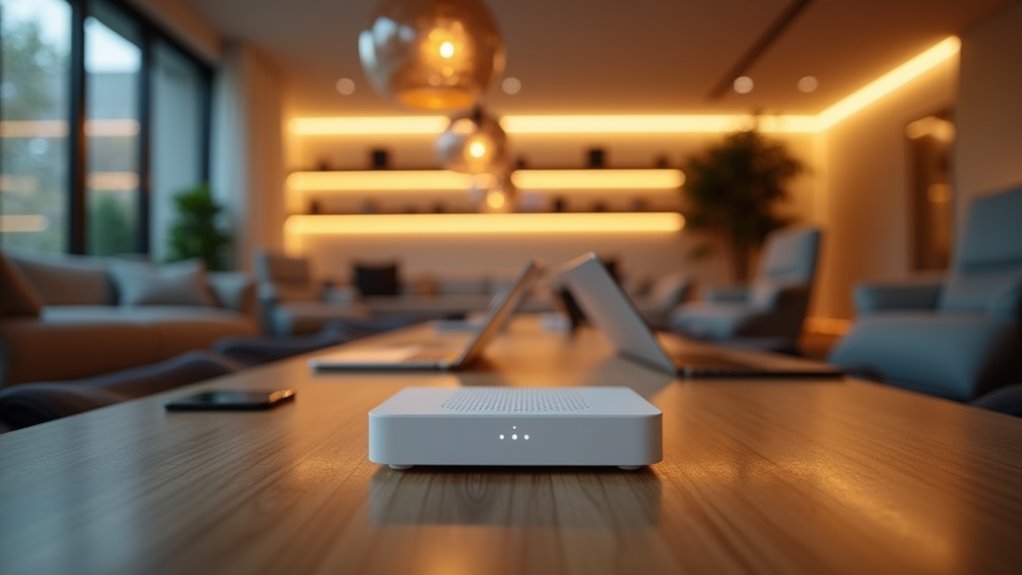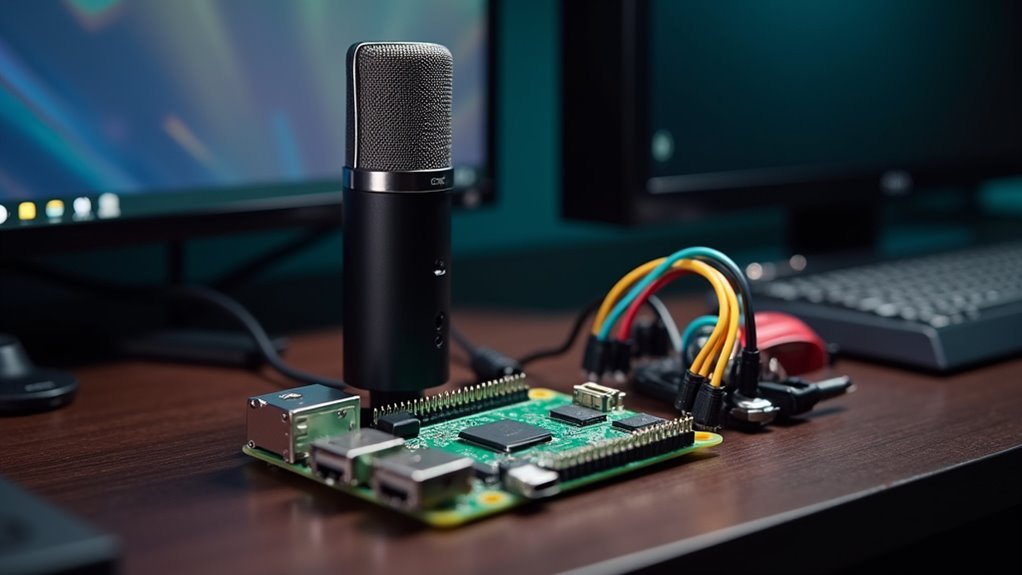You’ve probably experienced the frustration of watching your WiFi signal disappear as you move from room to room, leaving you with buffering videos and dropped video calls in certain areas of your home. Traditional routers simply can’t provide consistent coverage throughout larger spaces, creating those annoying dead zones that disrupt your daily digital activities. Mesh WiFi technology changes everything by working differently than conventional wireless systems, but understanding exactly how it transforms your home’s connectivity requires examining what makes these systems so much more effective.
What Is Mesh Wifi Technology?

Traditional routers broadcast WiFi signals from a single point, creating frustrating dead zones and weak connections in distant rooms.
Mesh WiFi technology solves this problem by using multiple interconnected nodes that work together as a unified network. Instead of relying on one router, you’ll have several access points strategically placed throughout your home, ensuring strong signals reach every corner.
Multiple WiFi nodes work together as one unified network, strategically placed throughout your home to eliminate dead zones completely.
Each node communicates with others to find the most efficient paths for your connected devices, maintaining peak performance even if one node fails.
The system automatically configures itself, making expansion simple—just add more nodes without complicated setup processes.
You’ll experience seamless roaming as you move between rooms, with your devices automatically connecting to the strongest available signal for consistently reliable WiFi coverage.
How Mesh Networks Eliminate Dead Zones
While single routers create frustrating coverage gaps, mesh networks strategically eliminate dead zones by deploying multiple nodes that blanket your entire home with overlapping WiFi signals. Unlike traditional routers that broadcast from one central point, mesh systems create multiple coverage areas that strengthen signal strength throughout challenging layouts.
| Traditional Router Setup | Mesh Network Setup |
|---|---|
| Single point signal emission | Multiple interconnected nodes |
| Weak spots in distant areas | Overlapping coverage zones |
| Dead zones in complex layouts | Seamless WiFi coverage everywhere |
Each node communicates with others, ensuring robust connectivity even when obstacles interfere. If one node encounters problems, the network automatically reroutes signals through alternate paths. This intelligent design provides seamless WiFi coverage across multiple floors and complex floor plans, effectively eliminating the dead zones that plague single-router setups.
Seamless Coverage for Large Homes

When your home spans multiple floors or exceeds 3,000 square feet, mesh WiFi systems become essential for maintaining strong connectivity throughout every room.
Traditional routers can’t deliver consistent WiFi across such expansive spaces, leaving you with frustrating dead zones and unreliable connections.
Mesh WiFi systems excel in large homes by deploying multiple interconnected nodes that create overlapping coverage zones.
Multiple interconnected nodes work together to eliminate dead zones and deliver seamless WiFi coverage throughout every corner of your home.
This whole home WiFi system guarantees you’ll experience greater WiFi coverage from your basement to your attic.
Each node communicates with others, automatically directing your devices to the strongest signal as you move throughout your home.
With coverage extending up to 6,000 square feet, you’ll enjoy a reliable connection whether you’re working in your home office or streaming in the master bedroom.
Supporting Multiple Connected Devices
Beyond covering extensive square footage, mesh WiFi systems shine when managing the dozens of connected devices that populate today’s smart homes. You’ll experience consistent connectivity across over 200 simultaneous device connections without performance degradation.
Mesh WiFi networks utilize advanced technologies like MU-MIMO and quad-band capabilities to distribute bandwidth efficiently among multiple connected devices. This eliminates the slowdowns you’d typically face with traditional routers as your device count increases.
| Feature | Benefit |
|---|---|
| 200+ Device Support | Accommodates all smart home devices |
| MU-MIMO Technology | Reduces latency across connections |
| Quad-band Distribution | Maintains stable performance |
| Easy Node Addition | Simple scalability expansion |
The scalability of mesh systems means you can easily add nodes as your smart home grows, ensuring every device maintains peak performance throughout your network.
WiFi 7 Speed and Performance Advantages

As connectivity demands intensify across modern households, WiFi 7 delivers unprecedented performance capabilities that transform your home networking experience.
You’ll experience revolutionary speeds up to 27Gbps, dramatically surpassing WiFi 6’s limitations while supporting bandwidth-intensive activities like 8K streaming and competitive gaming.
WiFi 7’s advanced features provide exceptional benefits for smart homes:
- Multi-Link Operation (MLO) transmits data across multiple channels simultaneously, maximizing network efficiency
- Quad-band capability connects over 200 devices without performance degradation
- Ultra-low latency guarantees seamless real-time applications and video conferencing
- Optimized coverage maintains consistent performance throughout larger homes with complex layouts
You’ll notice immediate improvements in overall network efficiency as WiFi 7’s enhanced architecture eliminates bottlenecks that previously limited your connected devices’ performance in demanding smart home environments.
Easy Setup Through Mobile Apps
Why struggle with complex router configurations when modern mesh WiFi systems transform setup into a simple, guided experience? Most mesh systems offer user-friendly mobile apps that walk you through installation, making it accessible regardless of your technical expertise. You’ll complete setup in minutes rather than hours spent wrestling with traditional router manuals.
These apps let you optimize signal strength by testing router and satellite placements, like the Orbi App’s positioning feature. You’ll enjoy real-time monitoring of network performance and can troubleshoot issues instantly. Plus, you can create guest networks and manage children’s screen time directly from your phone.
| Feature | Traditional Router | Mesh Mobile Apps |
|---|---|---|
| Setup Time | Hours of manual config | Minutes with guided steps |
| Signal Testing | Trial and error | Built-in placement optimization |
| Network Management | Web interface only | Convenient smartphone control |
| Issue Resolution | Complex troubleshooting | Real-time diagnostics and fixes |
Advanced Security Features and Protection
When cybercriminals target home networks with increasing sophistication, mesh WiFi systems respond with enterprise-grade security that protects every device on your network.
You’ll receive thorough protection through advanced security features that automatically safeguard your connected devices without requiring technical expertise.
Modern mesh systems deliver multi-layered defense:
- NETGEAR Armor provides real-time antivirus protection against malware and cyber threats across all connected devices
- WPA3 encryption creates stronger network security, making unauthorized access considerably more difficult
- Content filtering capabilities allow you to customize online experiences and protect children from inappropriate websites
- TP-Link HomeCare offers lifetime security subscriptions with certain mesh systems, eliminating ongoing costs
Regular firmware updates automatically patch vulnerabilities, ensuring your network maintains peak security performance while you focus on enjoying seamless connectivity.
Scalability and Network Expansion Options
While traditional routers force you to accept fixed coverage limitations, mesh WiFi systems offer unmatched flexibility that grows with your changing needs.
You can easily add nodes to extend coverage up to 10,000 square feet with quad-band configurations, ensuring consistent WiFi performance throughout your entire property. The modular design lets you customize network expansion by targeting specific areas like garages or outdoor spaces without complex setups.
As your household grows, scalability becomes effortless. You’ll support over 200 smart devices simultaneously without sacrificing speed or reliability.
The self-configuring technology integrates new nodes seamlessly, never disrupting your existing network. You can prioritize connections for specific devices based on your unique requirements, making mesh WiFi systems the perfect long-term solution for evolving connectivity demands.
Smart Home Device Integration
Your mesh WiFi system transforms into the perfect foundation for smart home integration, eliminating the connectivity dead zones that can frustrate your IoT devices.
You’ll experience seamless device connectivity as your mesh network creates a unified environment where smart thermostats, security cameras, and voice assistants communicate effortlessly.
The system’s smart hub functionality centralizes device management, letting you control your entire connected ecosystem through a single, streamlined interface.
Seamless Device Connectivity
As smart home technology becomes increasingly prevalent, mesh WiFi systems deliver the robust, consistent connectivity your devices demand across every corner of your home.
Unlike traditional routers that create dead zones, mesh networks guarantee strong connectivity throughout multiple rooms, supporting over 200 multiple devices simultaneously without performance degradation.
The seamless roaming feature automatically connects your smart home devices to the strongest available signal as you move through your space. This eliminates interruptions and maintains peak performance for all your connected gadgets.
Key connectivity advantages include:
- Consistent Performance: WiFi 6 technology optimizes bandwidth for high-demand applications
- Zero Lag: Real-time streaming and gaming operate without interruption
- Automatic Switching: Devices connect to peak signals without manual intervention
- Easy Management: User-friendly apps prioritize device connectivity based on your specific needs
Smart Hub Functionality
Beyond providing exceptional connectivity, modern mesh WiFi systems transform into extensive smart hubs that centralize control of your entire connected ecosystem.
You’ll manage lights, security cameras, and thermostats through a single network interface, eliminating the complexity of multiple apps and controllers.
Most mesh WiFi systems support Zigbee and Z-Wave protocols, ensuring compatibility with virtually any smart home devices you choose.
The bandwidth prioritization feature guarantees your security cameras and streaming devices receive peak performance when you need it most.
You’ll appreciate the user-friendly apps that simplify device setup, scheduling, and remote control.
Enhanced security features like automatic firmware updates and encryption protect your connected devices from cyber threats, giving you peace of mind about your smart home’s vulnerability.
Automatic Signal Optimization
When you install a mesh WiFi system, it doesn’t just broadcast signals randomly—it intelligently manages your network’s performance through automatic signal enhancement.
This sophisticated technology guarantees you’ll experience consistent performance across every device in your home, regardless of location.
Your mesh WiFi systems continuously work behind the scenes to deliver exceptional connectivity:
- Dynamic path selection – Routes data through the strongest available connections for ideal speeds
- Band steering technology – Automatically connects devices to the fastest available frequency band
- Self-healing technology – Instantly reroutes traffic around failed nodes to prevent disruptions
- Real-time network adjustments – Adapts to changing conditions for maintained high speeds
This intelligent approach assures reliable coverage throughout larger homes with complex layouts, guaranteeing seamless browsing experiences everywhere.
Cost Benefits Over Traditional Router Solutions
When you invest in a mesh WiFi system, you’re making a smart financial decision that pays dividends over time.
You’ll avoid the constant cycle of buying additional routers, extenders, and replacement equipment that traditional setups often require.
This long-term approach means fewer hardware replacements and lower overall costs as your network needs evolve.
Long-Term Investment Value
Although mesh WiFi systems carry a higher upfront cost than traditional routers, they’ll save you money over time by eliminating the need for multiple range extenders that can quickly add up.
These systems deliver exceptional long-term savings through extensive whole-home coverage extending up to 10,000 sq. ft., reducing costly equipment upgrades.
Your mesh network’s value compounds through:
- Device capacity – Support for 200+ devices simultaneously to reduce network slowdowns
- Built-in security – Automatic firmware updates eliminate subscription service costs
- Smart home optimization – Enhanced connectivity for all devices improves energy efficiency
- Future-proof design – Scalable coverage prevents frequent hardware replacements
You’ll maximize your investment as mesh WiFi systems enhance smart home devices while delivering seamless connectivity that eliminates dead zones and productivity losses.
Reduced Equipment Replacement
Traditional router setups can trap you in an expensive cycle of equipment purchases, but mesh WiFi systems break this pattern by delivering extensive coverage with fewer devices.
You’ll reduce equipment replacement frequency since mesh networks utilize advanced technology that extends hardware lifespans considerably beyond conventional routers.
Automatic firmware updates keep your mesh WiFi systems current without requiring new hardware purchases. This continuous optimization maintains peak performance and security, eliminating the need to buy updated equipment every few years.
You’re investing in technology that evolves with your needs rather than becoming obsolete.
Enhanced network efficiency means you won’t need additional boosters, extenders, or backup routers to maintain reliable connectivity.
The scalable nature of mesh systems allows strategic expansion without replacing your entire network infrastructure, maximizing your initial investment’s value.
Energy Efficiency of Mesh Systems
Since mesh WiFi systems distribute network management across multiple nodes, they’re inherently more energy-efficient than traditional setups that rely on a single router working overtime with multiple extenders.
This distributed approach allows mesh systems to reduce energy consumption while maintaining ideal signal strength throughout your home.
Modern mesh networks incorporate advanced energy-saving features that automatically adjust power consumption based on demand:
- Adaptive power control adjusts output levels based on current network activity
- Automatic sleep modes activate during periods of low usage
- Optimized signal distribution prevents devices from constantly searching for stronger connections
- Built-in energy monitoring lets you track your network’s power consumption through mobile apps
Choosing the Right Mesh System Size
When selecting a mesh system, you’ll need to match the coverage capacity to your home’s total square footage, as systems range from handling 3,000 to over 10,000 square feet depending on the model.
You should plan for multiple nodes if your home exceeds 2,000 square feet, with each additional node extending coverage by roughly 1,000 to 2,000 square feet.
Your specific layout, obstacles, and the number of connected devices will determine how many nodes you’ll actually need for peak performance.
Coverage Area Requirements
Determining your home’s coverage needs is the foundation for selecting the right mesh WiFi system size. Coverage area requirements vary greatly based on your home’s square footage and layout complexity. Mesh systems excel at eliminating dead zones in homes larger than 2,000 sq. ft., providing seamless connectivity where traditional routers fail.
Consider these key factors when evaluating your coverage needs:
- Home size – Mesh systems effectively cover up to 6,000 sq. ft.
- Layout complexity – Multi-story homes and complex floor plans require strategic node placement.
- Node quantity – More expansive homes need additional satellites for ideal coverage.
- Future scalability – Choose systems allowing outdoor expansion for yards and garages.
You’ll need to maintain strong signal strength between nodes through proper positioning within range of each other.
Node Count Planning
Once you’ve assessed your coverage area, the next step involves calculating how many nodes you’ll need to create that extensive network.
Node count planning for your mesh WiFi system starts with the basic rule: one node per 1,500-2,000 square feet. If your home exceeds 2,000 square feet, you’ll need at least two nodes to guarantee proper coverage overlap and eliminate dead zones.
Complex layouts with multiple floors or thick walls require additional nodes to maintain consistent connectivity throughout your space.
Position nodes within 30-50 feet of each other for peak performance. The beauty of mesh systems lies in their scalability—you can easily add more nodes later without complicated reconfiguration, making your investment future-proof as your connectivity needs evolve.
Professional Vs Consumer Grade Options
As you evaluate mesh WiFi systems for your home, you’ll encounter two distinct categories: professional-grade and consumer-grade options.
Professional-grade mesh WiFi systems like HP’s Aruba Instant On AP22 deliver superior performance capabilities with tri-band support and speeds reaching 1.7 Gbps, making them ideal for demanding environments.
However, consumer-grade mesh systems such as Eero Pro focus on accessibility and affordability.
Key differences include:
- Performance: Professional systems offer higher throughput versus consumer speeds of 600 Mbps to 1.2 Gbps
- Security features: Enterprise-level protections versus standard WPA2/WPA3 encryption
- Setup and management: Consumer systems provide intuitive apps while professional options require technical knowledge
- Target audience: Professional mesh networking suits businesses; consumer-grade mesh systems serve typical households
Frequently Asked Questions
What Is the Disadvantage of Mesh Wifi?
You’ll face higher upfront costs since mesh systems require multiple nodes. You might encounter complex setup processes, potential latency issues with poor placement, and diminished performance if you add too many nodes.
Is Mesh Wifi Better Than Normal Wifi?
You’ll find mesh WiFi superior to normal WiFi because it eliminates dead zones, supports more devices simultaneously, offers self-healing capabilities, and provides easier scalability without requiring separate network setups.
Will Mesh Wifi Go Through Walls?
Mesh WiFi doesn’t physically penetrate walls better than traditional routers, but you’ll get improved coverage because multiple nodes work together, routing signals around obstacles and eliminating dead zones throughout your home.
What Must Be Avoided in a Mesh Network?
You must avoid placing nodes too far apart, blocking them with furniture, using single-band systems in dense environments, overloading individual nodes with devices, and neglecting firmware updates.





Leave a Reply